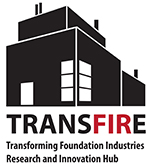As the costs of goods and services continue to rise and the world looks for ways to become more efficient and sustainable, an approach called Gentani is being used to help reduce waste and inefficiency. Gentani is a Japanese word that means output level or consumption rate, but in these circumstances, it means the minimum resource you need to carry out a process.
Using this approach, over the past few months TransFIRe’s Workstream 1 (WS1) have been able to map the energy and material flows at the UK level for all six of the foundation industries (cement, chemicals, ceramics, metals, plastics and paper) to identify potential opportunities for improvement and symbiosis. The researchers are also developing an approach to present the combined energy and material flows that will allow reporting data in a concise, transparent and flexible manner.
The new approach has the flexibility to scale from company to global level and from a daily to an annual basis. It also gives the necessary information to calculate all main metrics or cross-check values reported.
An example of the energy mapping for the cement industry in the UK is shown with key metrics on the left-hand side below. When compared to global metrics, the TransFIRe research showed that the UK has higher energy consumption and CO2 emissions. The reason for such high emissions is due to the higher content of clinker in British cement compared to global levels. Beyond that, the research has been looking into the potential improvements that could be achieved by deploying best practices available in the sector.

Figure 1. Resource flows for cement in the UK. Resource flows for cement. In the metrics table, the UK (BP) refers to a potential performance when the best practice is implemented; UK is the current UK average, and Global is the current Global average. The reference year is 2019.
Moving forward, WS1 are now taking an even more detailed approach and the main steps of the manufacturing process of key products for the six foundation industries are now being mapped. As this is done, the most relevant steps are presented in a way that allows cross-sector comparison to identify similarities between sectors and the potential of knowledge transfer through best practices. This visualisation will provide insights into the efficiency of the process and will highlight the opportunities for industrial symbiosis and efficiency gains.

